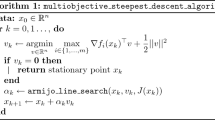Abstract
We propose two Newton-type methods for solving (possibly) nonconvex unconstrained multiobjective optimization problems. The first is directly inspired by the Newton method designed to solve convex problems, whereas the second uses second-order information of the objective functions with ingredients of the steepest descent method. One of the key points of our approaches is to impose some safeguard strategies on the search directions. These strategies are associated to the conditions that prevent, at each iteration, the search direction to be too close to orthogonality with the multiobjective steepest descent direction and require a proportionality between the lengths of such directions. In order to fulfill the demanded safeguard conditions on the search directions of Newton-type methods, we adopt the technique in which the Hessians are modified, if necessary, by adding multiples of the identity. For our first Newton-type method, it is also shown that, under convexity assumptions, the local superlinear rate of convergence (or quadratic, in the case where the Hessians of the objectives are Lipschitz continuous) to a local efficient point of the given problem is recovered. The global convergences of the aforementioned methods are based, first, on presenting and establishing the global convergence of a general algorithm and, then, showing that the new methods fall in this general algorithm. Numerical experiments illustrating the practical advantages of the proposed Newton-type schemes are presented.






Similar content being viewed by others
Data availability statement
The codes supporting the numerical experiments are freely available in the Github repository, https://github.com/lfprudente/newtonMOP.
References
Anderson, E., Bai, Z., Bischof, C., Blackford, S., Demmel, J., Dongarra, J., Du Croz, J., Greenbaum, A., Hammarling, S., McKenney, A., Sorensen, D.: LAPACK Users’ Guide, 3rd edn. SIAM, Philadelphia (1999)
Ansary, M.A., Panda, G.: A modified Quasi-Newton method for vector optimization problem. Optimization 64(11), 2289–2306 (2015)
Assunção, P.B., Ferreira, O.P., Prudente, L.F.: Conditional gradient method for multiobjective optimization. Comput. Optim. Appl. 78, 741–768 (2021). https://doi.org/10.1007/s10589-020-00260-5
Birgin, E., Martinez, J.: Practical Augmented Lagrangian Methods for Constrained Optimization. SIAM, Philadelphia (2014)
Bonnel, H., Iusem, A.N., Svaiter, B.F.: Proximal methods in vector optimization. SIAM J. Optim. 15(4), 953–970 (2005)
Custódio, A.L., Madeira, J.F.A., Vaz, A.I.F., Vicente, L.N.: Direct multisearch for multiobjective optimization. SIAM J. Optim. 21(3), 1109–1140 (2011). https://doi.org/10.1137/10079731X
Dai, Y.H.: Convergence properties of the BFGS algorithm. SIAM J. Optim. 13(3), 693–701 (2002)
Dai, Y.H.: A perfect example for the BFGS method. Math. Program. 138(1–2), 501–530 (2013)
Das, I., Dennis, J.: Normal-boundary intersection: a new method for generating the Pareto surface in nonlinear multicriteria optimization problems. SIAM J. Optim. 8(3), 631–657 (1998)
Dolan, E.D., Moré, J.J.: Benchmarking optimization software with performance profiles. Math. Program. 91(2), 201–213 (2002)
Fazzio, N.S., Schuverdt, M.L.: Convergence analysis of a nonmonotone projected gradient method for multiobjective optimization problems. Optim. Lett. 13(6), 1365–1379 (2019)
Fliege, J., Graña Drummond, L.M., Svaiter, B.F.: Newton’s method for multiobjective optimization. SIAM J. Optim. 20(2), 602–626 (2009)
Fliege, J., Svaiter, B.F.: Steepest descent methods for multicriteria optimization. Math. Method. Oper. Res. 51(3), 479–494 (2000)
Fukuda, E.H., Graña Drummond, L.M.: Inexact projected gradient method for vector optimization. Comput. Optim. Appl. 54(3), 473–493 (2013)
Geoffrion, A.M.: Proper efficiency and the theory of vector maximization. J. Math. Anal. Appl. 22(3), 618–630 (1968)
Gonçalves, M.L.N., Prudente, L.F.: On the extension of the Hager–Zhang conjugate gradient method for vector optimization. Comput. Optim. Appl. 76(3), 889–916 (2020)
Graña Drummond, L.M., Iusem, A.N.: A projected gradient method for vector optimization problems. Comput. Optim. Appl. 28(1), 5–29 (2004)
Graña Drummond, L.M., Raupp, F.M.P., Svaiter, B.F.: A quadratically convergent Newton method for vector optimization. Optimization 63(5), 661–677 (2014)
Graña Drummond, L.M., Svaiter, B.F.: A steepest descent method for vector optimization. J. Comput. Appl. Math. 175(2), 395–414 (2005)
Hillermeier, C.: Generalized homotopy approach to multiobjective optimization. J. Optimiz. Theory App. 110(3), 557–583 (2001)
Huband, S., Hingston, P., Barone, L., While, L.: A review of multiobjective test problems and a scalable test problem toolkit. IEEE Trans. Evolut. Comput. 10(5), 477–506 (2006)
Jin, Y., Olhofer, M., Sendhoff, B.: Dynamic weighted aggregation for evolutionary multi-objective optimization: Why does it work and how? In: Proceedings of the 3rd Annual Conference on Genetic and Evolutionary Computation, GECCO’01, pp. 1042-1049. Morgan Kaufmann Publishers Inc., San Francisco, CA, USA (2001)
Kim, I., de Weck, O.: Adaptive weighted-sum method for bi-objective optimization: Pareto front generation. Struct. Multidiscip. Optim. 29(2), 149–158 (2005)
Laumanns, M., Thiele, L., Deb, K., Zitzler, E.: Combining convergence and diversity in evolutionary multiobjective optimization. Evol. Comput. 10(3), 263–282 (2002)
Lovison, A.: Singular continuation: generating piecewise linear approximations to Pareto sets via global analysis. SIAM J. Optim. 21(2), 463–490 (2011)
Luc, D.T.: Theory of vector optimization. Lectures Notes in economics and mathematical systems, Vol. 319 (1989)
Lucambio Pérez, L.R., Prudente, L.F.: Nonlinear conjugate gradient methods for vector optimization. SIAM J. Optim. 28(3), 2690–2720 (2018)
Lucambio Pérez, L.R., Prudente, L.F.: A Wolfe line search algorithm for vector optimization. ACM Trans. Math. Softw. 45(4), 23 (2019)
Mascarenhas, W.F.: The BFGS method with exact line searches fails for non-convex objective functions. Math. Program. 99(1), 49–61 (2004)
Mascarenhas, W.F.: On the divergence of line search methods. Comput. Appl. Math. 26(1), 129–169 (2007)
Miglierina, E., Molho, E., Recchioni, M.: Box-constrained multi-objective optimization: a gradient-like method without a priori scalarization. Eur. J. Oper. Res. 188(3), 662–682 (2008)
Mita, K., Fukuda, E.H., Yamashita, N.: Nonmonotone line searches for unconstrained multiobjective optimization problems. J. Global Optim. 75, 63–90 (2019)
Moré, J.J., Garbow, B.S., Hillstrom, K.E.: Testing unconstrained optimization software. ACM Trans. Math. Softw. 7(1), 17–41 (1981)
Nocedal, J., Wright, S.: Numerical optimization. Springer (2006)
Povalej, Z.: Quasi-Newton method for multiobjective optimization. J. Comput. Appl. Math. 255, 765–777 (2014)
Preuss, M., Naujoks, B., Rudolph, G.: Pareto set and EMOA behavior for simple multimodal multiobjective functions. In: Runarsson, T.P., Beyer, H.G., Burke, E., Merelo-Guervós, J.J., Whitley, L.D., Yao, X. (eds.) Parallel Problem Solving from Nature - PPSN IX, pp. 513–522. Springer, Berlin (2006)
Qu, S., Ji, Y., Jiang, J., Zhang, Q.: Nonmonotone gradient methods for vector optimization with a portfolio optimization application. Eur. J. Oper. Res. 263(2), 356–366 (2017)
Schütze, O., Laumanns, M., Coello Coello, C.A., Dellnitz, M., Talbi, E.G.: Convergence of stochastic search algorithms to finite size Pareto set approximations. J. Global Optim. 41(4), 559–577 (2008)
Svaiter, B.F.: The multiobjective steepest descent direction is not Lipschitz continuous, but is Hölder continuous. Oper. Res. Lett. 46(4), 430–433 (2018)
Toint, P.L.: Test problems for partially separable optimization and results for the routine PSPMIN. The University of Namur, Department of Mathematics, Belgium, Tech. Rep (1983)
Wang, J., Hu, Y., Wai, Yu., C.K., Li, C., Yang, X.: Extended Newton methods for multiobjective optimization: majorizing function technique and convergence analysis. SIAM J. Optim. 29(3), 2388–2421 (2019)
Acknowledgements
This work was funded by FAPEG (Grants PRONEM-201710267000532, PPP03/15-201810267001725) and CNPq (Grants 302666/2017-6, 408123/2018-4, 424860/2018-0).
Author information
Authors and Affiliations
Corresponding author
Ethics declarations
Conflicts of interest
The authors declare that they have no conflict of interest.
Additional information
Publisher's Note
Springer Nature remains neutral with regard to jurisdictional claims in published maps and institutional affiliations.
Rights and permissions
Springer Nature or its licensor holds exclusive rights to this article under a publishing agreement with the author(s) or other rightsholder(s); author self-archiving of the accepted manuscript version of this article is solely governed by the terms of such publishing agreement and applicable law.
About this article
Cite this article
Gonçalves, M.L.N., Lima, F.S. & Prudente, L.F. Globally convergent Newton-type methods for multiobjective optimization. Comput Optim Appl 83, 403–434 (2022). https://doi.org/10.1007/s10589-022-00414-7
Received:
Accepted:
Published:
Issue Date:
DOI: https://doi.org/10.1007/s10589-022-00414-7




